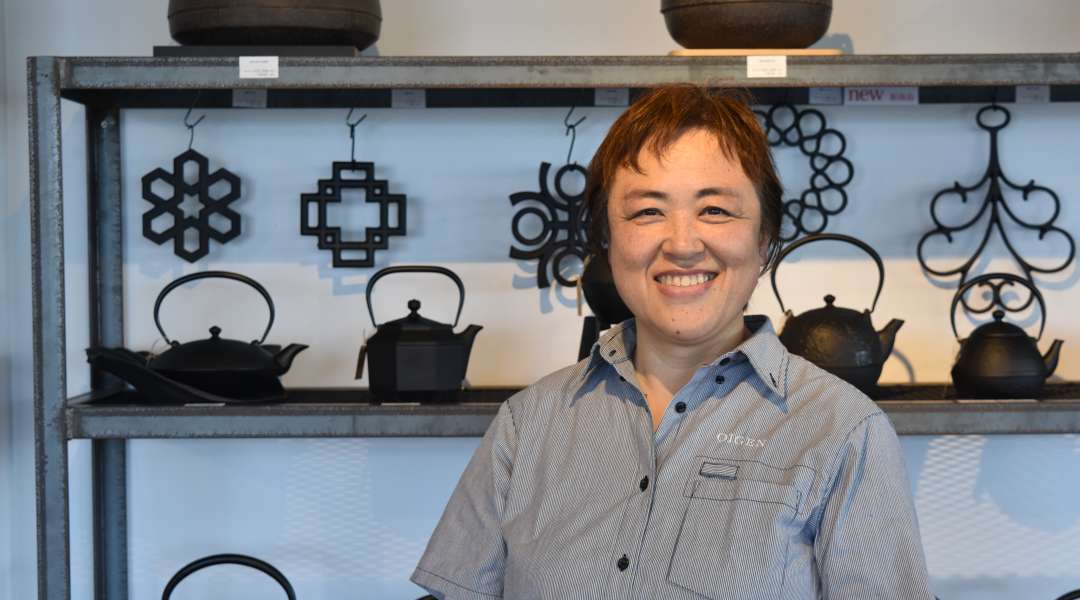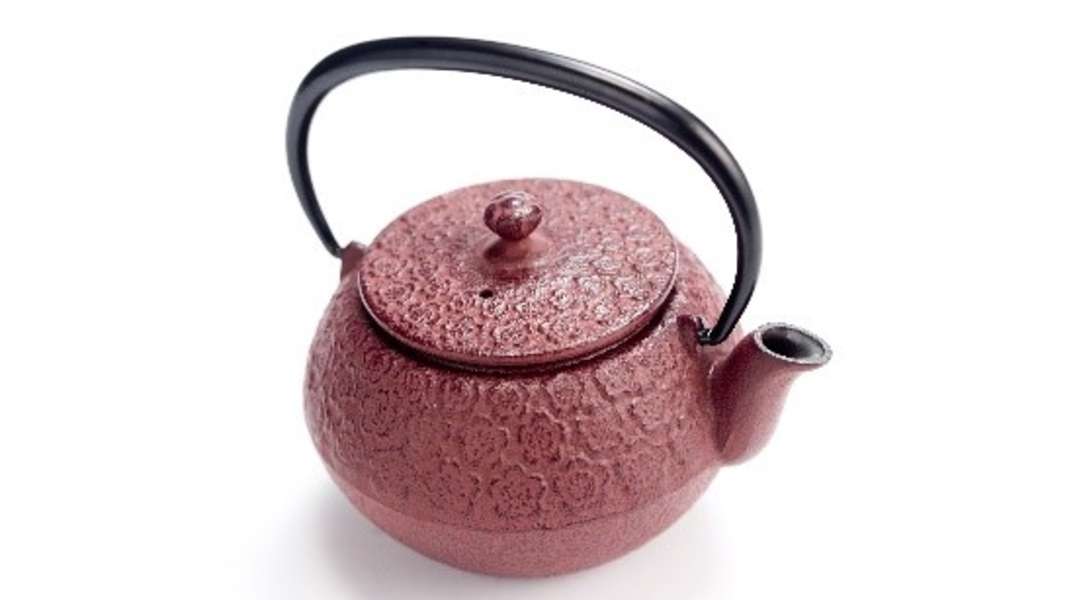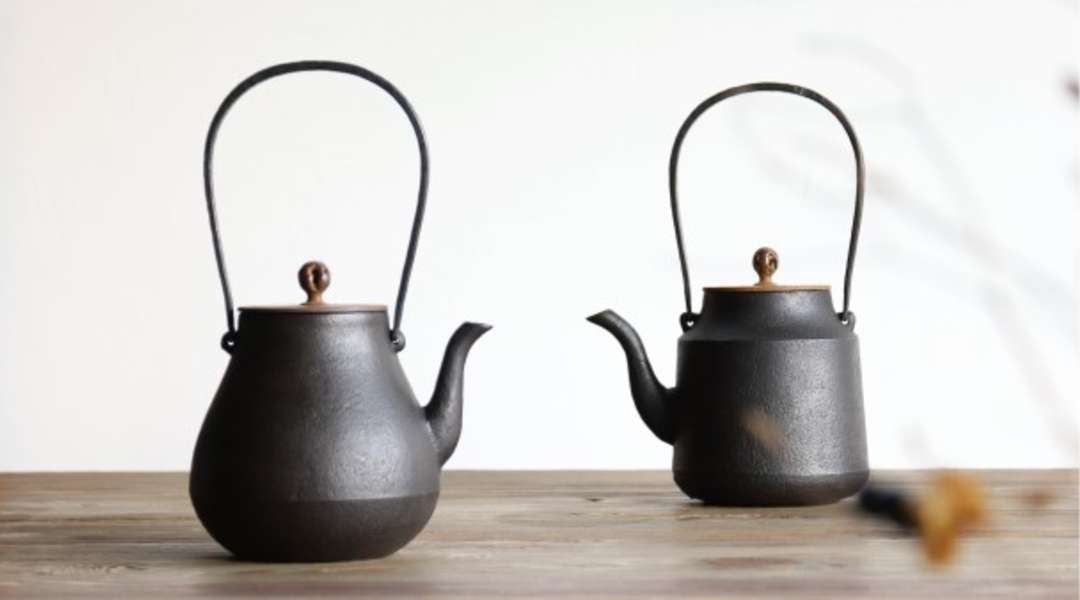
Located in the northeast of the Tohoku region, Iwate overlooks the Pacific Ocean via the Sanriku coastline and is buttressed by the Ou Mountains, home to some of Japan's best ski resorts and hot springs. Roughly divided into four distinct regions, Iwate is also marked by common themes of nature worship and traditional folklore, as well as samurai history and a long-standing tradition of high-quality metalwork craftsmanship. To find out more about this remote corner of Japan, we caught up with Oikawa-san to discuss all things Iwate and ferrous.
Hi Oikawa-san! Thanks so much for having us today. Would you mind giving us a quick self-introduction?
My name is Kuniko Oikawa and I’m the fifth generation owner of Oigen Castings, aka OIGEN, a business that makes Nanbu Ironware, one of Japan’s many traditional crafts. Nanbu Ironware is a brand name that came about around 60 years ago to define the specific type of iron-made products from Iwate prefecture but my specific workshop and has been making cast-iron goods since over 900 years ago in the Heian era when the temple complexes at nearby Hiraizumi had a lot of political power, and OIGEN as a business itself dates all the way back to 1852.
In department stores in London, you’ll actually sometimes see Nanbu products like cast-iron kettles and teapots but what actually is ‘Nanbu Ironware’?
'Nanbu Ironware’ is a general term for cast-iron goods made in Iwate prefecture, using the region’s specific natural resources but there’s a little bit of history behind it!
The main areas of production within what we now call Iwate prefecture were always Oshu city, where we are located, and Morioka city, where all the local government offices and things are, and historically they were different entities and not classified as the same prefecture. Looking at Iwate prefecture and its geography nowadays, you can see how both cities are blessed with exactly what’s needed to make good ironware (eg. iron, sand, ironsand, clay, charcoal and large north-south waterways) and even after the Oshu region and others nearby lost their power to the Kamakura Shogun in the early 1000s, the workmen in the region were able to hand down the skills and techniques of iron casting through a combination of agricultural practice and craft work.
Fast forward to the Edo period (roughly 1600s to mid-1800s), and the tea culture boom put Morioka’s ironware kettles on the map while Oshu was busy making all the iron tools used by the politicians conveniently located just south along the waterways in Japan’s new capital of Tokyo, then known as Edo. In 1871, when the old Shōgun warlord system was overthrown and the new Meiji government made moves to create the prefectures we know and love today, Oshu and Morioka were both brought together within Iwate prefecture, their ironware prowess was combined and the Nanbu brand was born in order to properly represent them both.
A whirlwind tour of Japanese history! What can you tell us about the production process involved in making this high quality ironware?
There's quite a bit of variety in the production process - different companies do it different ways and there are also differences between the hand-made way of making kettles from the Edo period, and the industrialised way done using electricity and machinery.
What they all have in common, however, is the act of melting iron down until it’s like sand, pouring it into a mould and letting it harden into a usable final product. It’s then about polishing it up carefully, adding some colour to it and transforming it into a marketable product.

In households in the UK, it’s normal to heat water in an electric kettle but what is it that makes cast-iron kettles so special?
When you boil water in a cast-iron kettle, the kettle automatically purifies it, getting rid of the calcium and magnesium etc and making it soft. This is a property that really distinguishes cast-iron kettles from boiling apparatus made of other materials. In Japan, we have what we call ‘shiroyu’ ‘white water’, or water that’s been boiled over a fire as opposed to boiling water that comes out of the tap, and it's particularly popular amongst women due to the belief that it helps increase the temperature in your stomach and intestines, easing digestion. And this ‘white water’ is a mindful one that requires a slow boil. In my eyes, the time that it takes to produce the ‘white water’ is nourishment for the soul and I would go as far as to say that the process of boiling water in a cast-iron kettle is actually a process of allowing water to be reborn.

I remember actually comparing the water produced by an electric kettle and the ‘white water’ produced by a cast-iron kettle in a shop in London, and the young coffee sommelier who was there with me at the time turned to me in shock and said “You’ve changed my life!”
Your teapots come in all sorts of colours, with really lovely polished designs that really distinguish them from other brands. Is there a particular hot drink that you think tastes particularly delicious from a cast-iron teapot?
I'd probably say Pu’er tea - the kind you brew thoroughly with 100°C water.
Pu'er tea leaf pearls are usually quite stubborn but blossom beautifully in an iron teapot because of how well they keep the heat.
We’ve seen on your website that you have a factory shop on-site but do you accept English-speaking visitors into the workroom floor to have a look behind the scenes?
Yes, definitely. We have a youngster on hand to help out with English explanations of the process, and are always welcoming tourists from abroad. There’s also an English-speaking member of staff in the shop, so no worries on the language front. The team can explain all the ins and outs of how to use and care for anything we sell in the shop.

Is it possible to buy Nanbu Ironware products in the UK?
Absolutely! In London, we have stock at Japan House, Native & Co (who also ship to the EU) and Jasper Morrison.
In the UK, there is an increasing trend towards buying high quality products that last you a long time. If looked after properly, how long would one of your cast-iron teapots or kettles last someone on average?
The teapots have enamel on the inside but provided that doesn’t crack, they should last you a really long time. Getting 100 years of usage out of one isn’t impossible. But if they take a particularly tough tumble, cracks can appear in the teapots so do make sure to treat them with care.
We also recommend washing the colourful ones lightly with hot water. The way that they’re made means that the colour does change over time, and we like to enjoy the journey of the colours as they inevitably transform over the years. We also recommend making sure not to wash it too often or too aggressively so that you don’t end up with uneven colouring. We also generally advise against using harsh washing up brushes or wire wool.

The kettles also last a long time. Again, as long as you don’t accidentally cause any cracks, you could easily get away with using one every day for 50 years. It’s obviously up to you but, seeing as they are a traditional craft, we suggest using them in the traditional Japanese way (it comes with a detailed user guide!).

Are there any other bits you sell at the factory shop that you would recommend to visitors?
We actually have some great rust-resistant ‘nabe’ cooking pots, made with a non-chemical process called ‘name finish’.
They're available either in our shop or on our website and are great for fried dishes. You don’t get any of those nasty harmful chemicals coming out while you’re cooking with them and the flavours of the ingredients always come out tasting delicious.

Tell us a little bit about Oshu and what there is to do.
We're a long city, east to west, in the south of Iwate prefecture, and the differences in soil and weather across the eastern parts and western parts of the city mean we produce an abundance of interesting natural produce.
We're also a big producer of the iron nabe pots needed to cook those ingredients - there are actually over 20 iron foundries just in the Haneda district of the city, and the workmen there sell their products on an international level.
If you head out about 15 mins by car from the Haneda district you get into the mountains, and Kokusekiji Temple which is a 1300 year old National Heritage building, with an impressive wooden effigy of Yakushi-Nyorai, the medicine Buddha. The head priest there is actually a young guy who spent some time studying in the UK and who can explain the history and importance of the temple in English. Another 5mins or so from there is Japan’s largest thatched roof building, Shoboji temple, which stands out amongst the tree tops. It’s a must see!

Do you have any words for people planning a trip to Japan?
If you take the Tohoku Shinkansen about 2h30 from Tokyo station, you’ll reach Mizusawa-Esashi Station, which is a short 10min walk from us. The Tohoku region that we are a part of has a great wealth of its own northern history that has, over the course of history, been forgotten about in favour of places like Kyoto and Kamakura, despite all of its incredible points of interest.
Dances and celebrations where the human world meets the other; folklore tales of humans intermingling with ‘yokai’ spirits - I want people to come and discover Tohoku for themselves, with all of the fascinating experiences that lie hidden in between the lines written on the page.
It can feel like an extra effort to make it up our way, but it’s completely different to the Japan you’ll experience in Tokyo and Kyoto and I promise you it’s a trip you won’t regret.

Covid-19 currently has the whole world in a difficult place but how are things in Oshu at the moment?
Iwate Prefecture, where I live, is the only place in Japan that is yet to record a single case of infection since the outbreak came to Japan in January, so we haven’t fully felt the effects. That said we are taking all the necessary precautions with hygiene standards, social distancing and masks for customers, just to be safe.
To stay up to date with all the latest happenings in Japan follow us on Facebook or Twitter.

















































